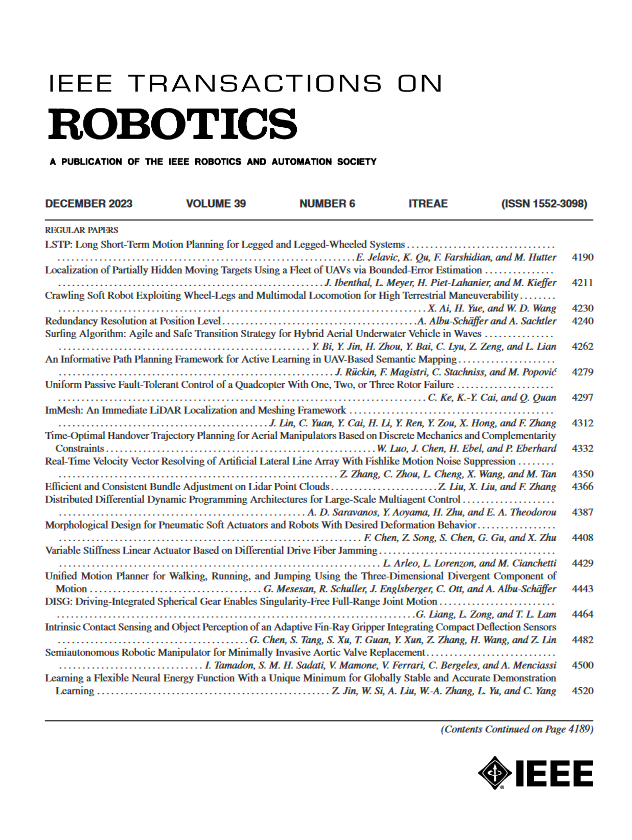《战术人》:基于触觉的无先验操作
IF 10.5
1区 计算机科学
Q1 ROBOTICS
引用次数: 0
摘要
将机器人集成到以人为中心的环境(如家庭)中,需要先进的操作技能,因为机器人设备将需要与门和抽屉等铰接物体接触。机器人操纵铰接物体的关键挑战是这些物体内部结构的不可预测性和多样性,这使得基于物体运动学先验的模型,无论是显式还是隐式,都是不充分的。它们的可靠性因相互作用前的模糊性、不完善的结构参数、遇到未知物体和不可预见的干扰而大大降低。在这里,我们提出了一个无先验策略,Tac-Man,专注于在操作过程中保持稳定的机器人-物体接触。在不依赖对象先验的情况下,Tac-Man利用触觉反馈使机器人能够熟练地处理各种铰接物体,包括那些具有复杂关节的物体,即使受到意外干扰的影响。在现实世界的实验和广泛的模拟中,它在动态和不同的环境中始终取得近乎完美的成功,优于现有的方法。我们的研究结果表明,触觉感知本身就足以管理各种铰接物体,比基于先验的方法提供更强的鲁棒性和泛化性。这强调了在复杂操作任务中详细接触建模的重要性,特别是对于铰接对象。触觉通知方法的进步显着扩大了机器人在以人为中心的环境中的应用范围,特别是在难以获得准确模型的情况下。本文章由计算机程序翻译,如有差异,请以英文原文为准。
Tac-Man: Tactile-Informed Prior-Free Manipulation of Articulated Objects
Integrating robots into human-centric environments such as homes, necessitates advanced manipulation skills as robotic devices will need to engage with articulated objects such as doors and drawers. Key challenges in robotic manipulation of articulated objects are the unpredictability and diversity of these objects' internal structures, which render models based on object kinematics priors, both explicit and implicit, and inadequate. Their reliability is significantly diminished by pre-interaction ambiguities, imperfect structural parameters, encounters with unknown objects, and unforeseen disturbances. Here, we present a
prior-free
strategy, Tac-Man, focusing on maintaining stable robot-object contact during manipulation. Without relying on object priors, Tac-Man leverages tactile feedback to enable robots to proficiently handle a variety of articulated objects, including those with complex joints, even when influenced by unexpected disturbances. Demonstrated in both real-world experiments and extensive simulations, it consistently achieves near-perfect success in dynamic and varied settings, outperforming existing methods. Our results indicate that tactile sensing alone suffices for managing diverse articulated objects, offering greater robustness and generalization than prior-based approaches. This underscores the importance of detailed contact modeling in complex manipulation tasks, especially with articulated objects. Advancements in tactile-informed approaches significantly expand the scope of robotic applications in human-centric environments, particularly where accurate models are difficult to obtain.
求助全文
通过发布文献求助,成功后即可免费获取论文全文。
去求助
来源期刊

IEEE Transactions on Robotics
工程技术-机器人学
CiteScore
14.90
自引率
5.10%
发文量
259
审稿时长
6.0 months
期刊介绍:
The IEEE Transactions on Robotics (T-RO) is dedicated to publishing fundamental papers covering all facets of robotics, drawing on interdisciplinary approaches from computer science, control systems, electrical engineering, mathematics, mechanical engineering, and beyond. From industrial applications to service and personal assistants, surgical operations to space, underwater, and remote exploration, robots and intelligent machines play pivotal roles across various domains, including entertainment, safety, search and rescue, military applications, agriculture, and intelligent vehicles.
Special emphasis is placed on intelligent machines and systems designed for unstructured environments, where a significant portion of the environment remains unknown and beyond direct sensing or control.
 求助内容:
求助内容: 应助结果提醒方式:
应助结果提醒方式:


